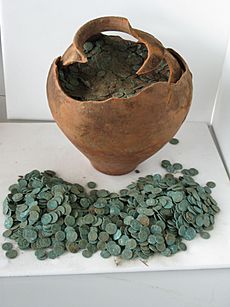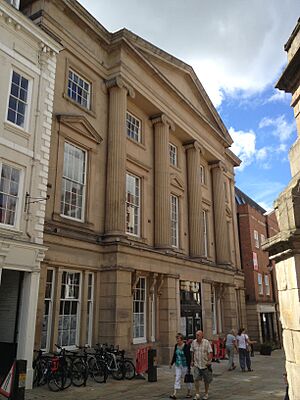Shrewsbury Museum and Art Gallery facts for kids

Shrewsbury Museum & Art Gallery at night
|
|
| Established | 1835 |
|---|---|
| Location | The Square, Shrewsbury, England |
| Type | Local Authority museum |
| Collection size | approx. 300,000 objects |
| Visitors | 300,000-350,000 expected per annum |
The Shrewsbury Museum and Art Gallery is a cool place to explore history and art in Shrewsbury, England. It first opened its doors way back in 1835. Back then, it was called the Museum of the Shropshire and North Wales Natural History and Antiquarian Society.
Over the years, the museum's amazing collections moved to different buildings. After 160 years, it found its current home. Today, you can find it in the historic Vaughan's Mansion and the Music Hall complex. This happened after a big project to update the site.
History of the Museum
The Shrewsbury Museum and Art Gallery started in 1835. It was first located in Dogpole, Shrewsbury. In 1853, its collections moved to Vaughan's Mansion. This building on College Hill then became known as the Shropshire and North Wales Museum.

In 1877, the museum's society joined with the Shropshire Archaeological Society. They became the Shropshire Archaeological and Natural History Society. That same year, the museum received a huge collection of items. These items were found during digs at Wroxeter, an ancient Roman town.
The museum celebrated its 50th birthday in 1885. At this time, the museum and library moved to the old Shrewsbury School building. The museum then became publicly owned by the Corporation of Shrewsbury. It was renamed the Shrewsbury Museum and Free Library.
In 1894, the museum's Curator, George Holt, wrote down some rules. These rules helped everyone know how to behave in the museum. For example, visitors were asked not to touch the objects. They also had to be respectful of the space.
In 1931, a building called 'Rowley's House' was bought. It was meant to hold ancient Roman items found near Wroxeter. This building opened to the public seven years later. It became known as the Uriconium or Roman Museum.
In 1974, local government changed. The museum's collections were moved to Rowley's House. In 1981, Rowley’s Mansion also opened. This expanded the Roman Museum, allowing it to show even more collections.
In 2009, the Shrewsbury Museum Service joined with the Shropshire County Museum Service. Today, Shropshire Council manages the museum. It is one of seven museum sites across the county.
Moving to the Music Hall
The Music Hall is a large Victorian building. It is located in the center of Shrewsbury. Shropshire Council owns this building. It used to be a theatre, but it was changed to become the new Shrewsbury Museum and Art Gallery.
The big project to change the building started in 2009. The town's theatre had moved to a new place called Theatre Severn. The old Music Hall is a very important site in Shrewsbury. It is in the oldest part of the town.
The museum is a mix of different buildings. It includes the Grade II* listed 13th-century Vaughan's Mansion. This is one of the few old defensive hall houses left in the UK. The main part of the site is the 19th-century Music Hall. It was designed in 1835 and is also a listed building.
The complex also has a medieval "shut." This is a narrow passageway common in Shrewsbury. There are also 19th-century police holding cells. These cells were used for people waiting for trials. A 20th-century civil defense bunker is also part of the site. The Music Hall site shows a lot about Shrewsbury's history. It even used to be where the town's fire service was located.
The buildings were carefully restored. This helped to show the history of Shrewsbury over 700 years. The museum's collections were also moved and displayed in new ways. Many items came from the old museum at Rowley's House. The new museum opened to visitors in 2014. It was officially opened on September 17, 2015, by the Duke of Gloucester.
In August 2019, the museum showed a new stained glass window. A local artist named Nathalie Hildegarde Liege created it. The window was inspired by the museum’s Hall of Rocks and Minerals. It was also inspired by an exhibition about artist Margaret Agnes Rope.
Amazing Collections
In 1835, the Shropshire and North Wales Natural History Society decided to create a museum. They wanted to collect items that showed the natural history of the area. This included geology, minerals, animals, and plants. They also wanted to keep ancient items found in the area.

...mainly to show the natural history of the area, including its geology, minerals, animals, and plants, by slowly building up complete collections of what is found here. It will also welcome other interesting scientific objects, and especially, it will be a good place for ancient items found in the area or that show its general history.
The museum encouraged local people to donate items. Many important local figures gave things to the museum. These included Sir Baldwin Leighton and Lord Berwick. Famous scientists also donated items. These included Charles Darwin, Henry Blunt, and Sir Roderick Impey Murchison.
Today, the collections are part of Shropshire Council's Shropshire Museums. The museum is especially strong in items from the Late Prehistoric and Roman times. It also has great geology collections. Some of its most important items include:
- The Hadrianic Forum Inscription from Wroxeter
- The Wroxeter Roman Mirror
- The Guilsfield Bronze Age Hoard
- The Condover Mammoths
- The Grinshill Rhynchosaur
- Two paintings of Coalbrookdale by William Williams from the mid-1700s
- A great auk specimen prepared by Henry Shaw
The museum also has a very good collection of Caughley porcelain. This is one of the best in the UK. In 2012 and 2013, the museum added new items. These included the Shrewsbury Hoard and a watercolor painting of the town by Michael Angelo Rooker.
See also
- Listed buildings in Shrewsbury (southeast central area)




